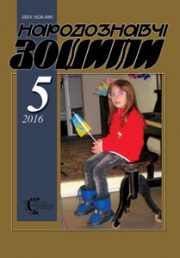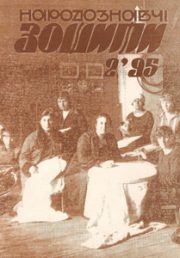The Ethnology Notebooks. 2023. № 5 (173), 1291—1304
DOI https://doi.org/10.15407/nz2023.05.1291
MAKOYDA Orest
- ORCID ID: http://orcid.org/0000-0001-6915-2481
- Candidate of Sciences in Arts (Ph.D),
- Head of Department,
- The Institute of Ethnology of the National Academy
- of Sciences of Ukraine,
- Department of Folk Art,
- 15, Svobody Avenue, 79000, Lviv, Ukraine,
- Contacts: e-mail: orestmakoyda@gmail.com
Abstract. Introduction. Expressionism occupied a special place in Ukrainian fine art. Among the Ukrainian artists of the beginning of the 20th century, there were those who were directly related to the expressionist movement: Vasyl Kandinsky, George Narbut, David and Volodymyr Burlyuk, Volodymyr Izdebsky, Oleksandra Ekster (Gryhorovych), Sonia Delaunay and others. These masters played an important role in artistic expressionist searches and the formation of a new Western European direction. The other group includes artists who did not belong to expressionist associations, but expressive features of expressionism are visible in their work. This list includes Oleksa Novakivskyi, Kazimir Sihulskyi, Osip Soroktei, Ivan Rubchak, Leopold Levytskyi and a whole list of original Galician masters. The study of the main expressionist tendencies in the work of Galician masters today is an important task of modern art history.
Article purpose. For a comprehensive study of this problem, it is important to identify the main cultural and artistic connections that connect the European expressionist trend with the processes that took place in the Galician lands.
The purpose of the article is to consider the cultural and artistic processes associated with the emergence of the expressionist movement in Poland at the beginning of the 20th century. Our task is to investigate the Krakow artistic environment of this period and determine its influence on the development of young Ukrainian artists who studied at the Academy of Arts. A particularly important task is the study of the ways through which expressionism got to the Galician territory. This fact will help to create a complete picture of the artistic phenomenon, which touches the expressionist direction in Ukrainian art. The study of this issue will allow singling out a separate cultural and artistic stratum, uniting and systematizing its representatives according to characteristic features.
Conclusion. Expressionist tendencies formed in Germany were reflected in many European countries. In the Polish visual arts of the end of the 19th — the beginning of 20th century in expressionist tendencies there are such features as sharpness of contrast, compositional fragmentation, spatial deformation, geometrization and dynamics of forms. The works of many Galician artists are endowed with similar features. This fact suggests the existence of special connections between Polish and Ukrainian art. To a large extent, these connections were facilitated by Polish art educational institutions. Many of them promoted expressionist orientation in art.
Krakow was the closest cultural center to the western Ukrainian lands. At the beginning of the 20th century, the best teachers in Poland were gathered in the Krakow Academy of Arts. Prominent Galician artists who managed to find their own artistic style became students of the Krakow Academy of Arts. A certain number of them worked in the frank manner of expressionism.
In this article, we examine the ways of the emergence of the expressionist movement in Poland. Also, the study presents an analysis of the creativity of representatives of expressionism who worked at the Krakow Academy or had another influence on Western Ukrainian art.
Keywords: expressionism, expressive, Krakow, Poland, artists, groups, stylistics, trends.
Received 2.10.2023
REFERENCES
- Richard, L., Tolmachev, V.M. (Ed.). (2003). Expressionism as an artistic movement. Encyclopedia of Expressionism: Painting and Graphics. Sculpture. Architecture. Literature. Dramaturgy. Theater. Movie. Music (Pp. 5—24). Moscow: Republic [in Russian].
- Verves, H. (1992). Ukrainian avant-garde in the context of European manifestos and programs. Word and Time, 12, 37 — 43 [in Ukrainian].
- Aseeva, N.Y. (1989). Ukrainian art and European art centers of the late 19th — early 20th centuries. Kiev: Naukova dumka [in Russian].
- Fedoruk, O.K. (1986). Sources of cultural relations: Ukraine in the works of Polish artists of the second half of the 19th and early 20th centuries. Kyiv [in Ukrainian].
- Gordon, D.E. (1987). Expressionism Art and Idea. London.
- Veselovska, H. (2003). Dramaturgy of Stanislav Przybyszewski on the stages of Kyiv theaters in the 1900s. Ukrainian-Polish cultural relations of the 19th—20th centuries (Pp. 154— 171). Kyiv [in Ukrainian].
- Juszczak, W. (1964). Wojtkiewicz and new art. Krakow [in Polish].
- Pronaszko, Z. (1917). Polish Expressionists. Masks, 1, 3 [in Polish].
- Malinowski, J. (1918). The «Jung Idysz» group and the Jewish «New Art» community in Poland 1918—1923. Warsaw [in Polish].
- Piotr Policht. Waves of rebellion, or three expressionisms. Retrieved from: https://culture.pl/pl/artykul/fale-buntu-niczy-trzy-ekspresjonizmy [in Polish].
- Myslavskyi, V.N. (2007). New language. Film dictionary. Terms, definitions, jargonisms. Kharkiv [in Ukrainian].
- Tkachuk, T.O. (2017). Perception of modernist ideas of Stanislav Przybyszewskii by Ukrainian literary studies. Prykarpatsky Bulletin of the Scientific Society named after Shevchenko (Issue 3 (39), pp. 355—365). Ivano-Frankivsk [in Ukrainian].
- Yavorskaya, V. (1977). Problems of symbolism in the painting of «Young Poland». Artistic processes in Russian and Polish art of the 19th — early 20th centuries (Pp. 35—74). Moscow [in Russian].
- Lukasiewicz, P., & Malinowski, J. (1980). Expressionism in Polish art. Wroclaw [in Polish].
- Juszczak, W. (1979). Young Weiss. Warsaw [in Polish].
- Dutkiewicz, Jozef E., Jeleniewska-Slesinska, Jadwiga, & Slesinski, Wladyslaw (Eds.). (1969). Materials for the history of the Academy of Fine Arts in Krakow: 1895—1939. Wroclaw; Warsaw; Krakow [in Polish].
- Irena Kossowska. Fryderyk Pautsch. Retrieved from: https://culture.pl/pl/tworca/fryderyk-pautsch [in Polish].
- Juszczak, W. (2000). Wojtkiewicz and new art (Ed. II). Krakow [in Polish].






